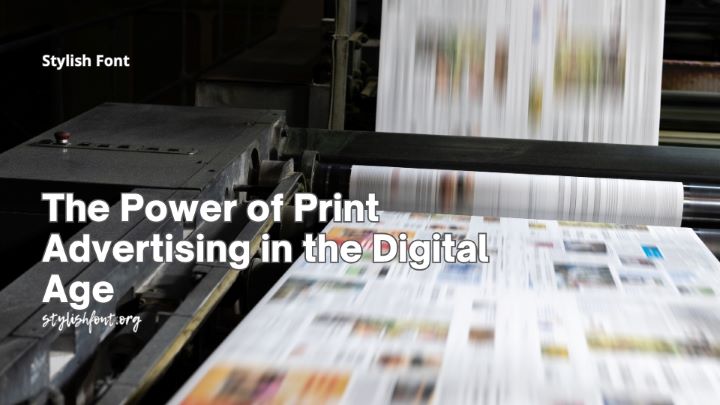Key Takeaways
- Print advertising remains a powerful brand tool, offering tangible and trusted content.
- Combining print and digital strategies can enhance overall marketing effectiveness.
- Data suggests that consumers view print ads as more credible and engaging than some digital formats.
The Resilience of Print Media
Print media has maintained a steadfast presence in a world increasingly dominated by digital content. Newspapers and magazines still find dedicated readers who value the tactile experience and in-depth stories only print can offer. Physical newspapers offer credibility, which some online news platforms need help to achieve due to the prevalence of false information or clickbait.
According to recent research, traditional print media attracts significant audiences who find printed content more trustworthy. Furthermore, print advertising plays a crucial role in this dynamic. It provides businesses with a unique and lasting way to reach their audience, offering them a tangible connection often missing in the digital realm.
Why Print Advertising Works
Print advertising provides a unique value proposition. Studies show that print ads are often viewed as more credible and less intrusive than digital ads. This perception of quality and trust can significantly enhance a brand’s reputation. Consumers tend to engage more deeply with print ads because they are present in an environment free from online distractions.
Furthermore, print advertisements are typically more memorable, partly due to the focused attention they receive from readers. According to a study, print ads often yield higher engagement rates and more profound brand recall. The tactile nature of print creates a sensory experience that digital ads can’t replicate, making the information more likely to stick with the audience.
Integrating Print and Digital Strategies
Combining traditional and digital advertising strategies can maximize reach and engagement. Printed ads can drive readers to digital platforms by incorporating QR codes, social media handles, or website URLs. This multi-channel approach ensures that a brand maintains a consistent presence across different media, leveraging the strengths of each to cover broader audience demographics.
For instance, a beautifully designed print ad in a magazine can include a QR code that directs readers to an online store. This strategic integration boosts user engagement and offers measurable metrics that can be meticulously tracked and analyzed to optimize future campaigns. Print and digital ads form a more unified and potent marketing approach when utilized in tandem.
Measuring the Success of Print Campaigns
While digital marketing campaigns often provide instant metrics, measuring the impact of print campaigns requires different strategies. Tracking mechanisms like unique promo codes, dedicated landing pages, and customer surveys can offer insights into the effectiveness of print advertising. For instance, a print ad could feature a unique code that provides a discount when entered online, making it easier to track which ads are driving sales.
By analyzing these metrics, brands can adjust their strategies to maximize ROI. Furthermore, combining these data points with digital insights can offer a more comprehensive view of a campaign’s performance. This hybrid approach allows businesses to continually refine their marketing tactics, ensuring both print and digital efforts contribute effectively to overall objectives.
Case Studies: Successful Print Ad Campaigns
Numerous brands have effectively harnessed the power of print advertising to amplify their marketing endeavors. One remarkable example is a company that consistently crafts compelling print ads to captivate readers and drive digital subscriptions. Their print editions showcase gripping investigative journalism and in-depth reports, distinguishing themselves from the easily consumable online content prevalent today.
Another noteworthy instance is the enduring appeal of detailed catalogs, which have become a mainstay in households across the globe. These printed catalogs exhibit products that inspire and captivate customers with imaginative home décor ideas. These examples underscore the potential of print ads to leave a lasting impact and spur consumer engagement.
Tips for Effective Print Advertising
- Focus on Quality Design: High-quality graphics and typography are crucial for catching the reader’s eye. Invest in professional design to ensure your print ad is visually appealing and stands out.
- Clear Messaging: Ensure that your ad’s message is straightforward and compelling. A clear and concise message helps deliver your brand’s value proposition effectively.
- Call to Action: Include a clear call to action, whether to visit a website, scan a QR code, or make a phone call. This not only directs the reader on what to do next but also provides a measurable action point for tracking the effectiveness of your ad.
- Targeted Distribution: Place your print advertisements in locations where your target audience is most likely to come across them. Consider specific magazines, newspapers, or personalized direct mail campaigns designed for a particular demographic.
Future Trends in Print Advertising
Despite the rise of digital, print advertising is evolving rather than fading away. Innovations like augmented reality (AR) in print media create interactive experiences that merge the physical and digital. This can transform a static print ad into an interactive experience, engaging readers in new and exciting ways.
Brands that remain creative and adaptive in their print advertising strategies will likely continue effectively capturing consumer interest. As the lines between digital and print continue to blur, the future holds promising possibilities for those willing to innovate and invest in high-quality print advertising solutions.





